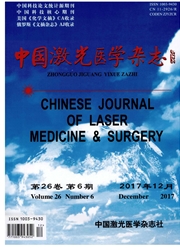

 中文摘要:
中文摘要:
目的观察不同功率密度下,578 nm激光引起的灰兔视网膜的改变,探讨影响激光对视网膜生物效应的因素。方法灰兔16只,32只眼,以波长578 nm、脉宽20~40 ns的脉冲铜蒸汽激光照射兔眼底视乳头下方的后极部,按照射眼底的激光功率密度分为435、869、1 304、1 739、2 174、2 608和3 043 mW/cm2 7组,照光时间100 s,眼底光斑直径2 mm。照光后24 h用检眼镜和眼底荧光造影检查视网膜的损伤,并行视网膜的组织病理学检查。结果波长为578 nm、频率为6 kHz的铜蒸汽激光,在眼底光斑直径为2 mm、照光时间为100 s的照光条件下,其功率密度越高,视网膜损伤越重。结论在激光波长578 nm照光时间相同和光斑大小不变的条件下,功率密度是影响激光对灰兔视网膜生物学效应的重要因素。
 英文摘要:
英文摘要:
Objective Using the 578nm laser with pulsewidths of 20-40ns on the retinas of rabbit eyes with different power density,to observe the change in the retinas and to research the relationship between the quantity of the laser and the retinal biology effect. Methods Thirty-two eyes of 16 grey rabbits were exposed to the laser with the wavelength of 578nm,the duration of 100s,and the spot size of 2mm.The grey rabbits were grouped by power density at 435,869,1304,1739,2174,2608 and 3043mW/cm2.The authors examined and scored all laser impact sites in the retina with the eyeground photography to identify evidence of visible laser effects at 24h after the exposure,and to observe the injured tissues under the eyeground photography and the microscope. ResultsUnder the same laser exposing condition with the wavelength of 578nm,the duration of 100s,and the spot size of 2mm,the retinas of grey rabbits were injured more seriously under the higher power density. ConclusionsAt the same exposing time and the same spot diameter,the power density is the very important element to determine the laser retinal biology effect.
 同期刊论文项目
同期刊论文项目
 同项目期刊论文
同项目期刊论文
 Preliminary Study on Oxygen Content Monitoring for Port Wine Stains during PDT Using Diffuse Reflect
Preliminary Study on Oxygen Content Monitoring for Port Wine Stains during PDT Using Diffuse Reflect Effects of Photodynamic Therapy Using Hematoporphyrin Monomethyl Ether on Experimental Choroidal Neo
Effects of Photodynamic Therapy Using Hematoporphyrin Monomethyl Ether on Experimental Choroidal Neo Fluorescence monitoring of a photosensitizer and prediction of the therapeutic effect of photodynami
Fluorescence monitoring of a photosensitizer and prediction of the therapeutic effect of photodynami 期刊信息
期刊信息
